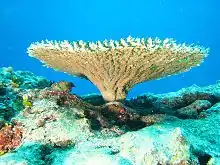Coral Triangle
The Coral Triangle (CT) is a roughly triangular area of the tropical marine waters of Indonesia, Malaysia, Papua New Guinea, Philippines, Solomon Islands and Timor-Leste that contain at least 500 species of reef-building corals in each ecoregion.[3] CT is located in equator, between Pacific and Indian Ocean [4] that encompasses portions of two biogeographic regions: the Indonesian-Philippines Region, and the Far Southwestern Pacific Region.[5] As part of eight major coral reef reef zone in the world,[6] CT is recognized as the global centre of marine biodiversity[7] and a global priority for conservation.[8] It is also called the "Amazon of the seas" and covers 5.7 million square kilometres (2,200,000 sq mi) of ocean waters.[9] Its biological resources categorize as a global hotspot of marine biodiversity that contains >76% of the world's shallow-water reef-building coral species, 37% of the world's reef fishes, 50% of razor clams, six out of seven of the world's sea turtles, and the largest mangrove forest in the world.[4] In 2014, the Asian Development Bank (ADB) reported a gross domestic product of the marine ecosystem in CT reaches $1.2 trillion per year for over 120 million people.[10][4] According to the Coral Triangle Knowledge Network, about $3 billion in fisheries exports and another $3 billion in coastal tourism revenues are derived as annual foreign exchange income in the region.
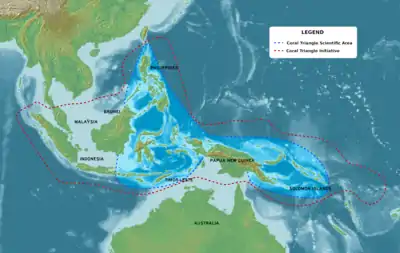
The WWF considers the region a top priority for marine conservation, and the organization is addressing the threats it faces through its CT Program,[11] launched in 2007. The center of biodiversity in the Triangle is the Verde Island Passage in the Philippines,[12] while the only coral reef site declared as a UNESCO World Heritage Site in the region is the Tubbataha Reef Natural Park, also in the Philippines.[13]
Biodiversity
While only covering 1.6% of the planet’s oceanic area, the region has 76% of all known coral species in the world. As a habitat for 52% of Indo-Pacific reef fishes and 37% of the world's reef fishes, it encompasses the highest diversity of coral reef fishes in the world[14] More than 3,000 species of bony fish distributed in > 90% CT area, including the largest fish - the whale shark, the coelacanth and the chimaerans.[4]
The CT is the epicentre for the biodiversity of not only corals and fish, but many other marine organisms as well. Molluscs which found around 950 species and crustacean 458 species, respectively.[4] It also provides habitat to six out of the world's seven marine turtle species.[4]
The highest richness areas (6%) were identified along the coast of the Philippines (northern part of Luzon, Sullivan Sea, Bohol, Mindanao, Palawan, and Sulu Archipelago), Malaysia (north-eastern part of Sabah), Indonesia (northern and south-eastern part of Sulawesi, Banda Sea, Mollucas, Raja Ampat Archipelago of Papua), Papua New Guinea (coastal area of Madang, New Britain, Milne Bay, Louisiade Archipelago, and Bougainville Island), and Solomon Islands (Guadalcanal Island and Makira Province).[4] However, more than half (70%) CT zone were classified as low species richness areas.[4]
The greatest extent of mangrove forests in the world also found in CT. The large area and extraordinary range of habitats and environmental conditions have played a major role in maintaining the staggering biodiversity of the Coral Triangle.[15]
Join expedition Indonesian–U.S.marine survey in 2008 discovers deep-sea biodiversity and underwater active volcanoes (3800meters) along the west ridge. Around 40 new deep coral sea species found in whitish color because the reef is not a habitat of shallow colorful algae. Both hydrothermal vent and deep coral support marine niche shrimps, crabs, barnacles, and sea cucumbers habitat in 4000meters deep.[16]
CT countries need more taxonomists and oceanographers to answer the new constraints of seeking diversity in the coral triangle. The statement following the Minister of Research and Technology / National Research and Innovation Agency (Menristek / Head of BRIN) of Indonesia, Bambang Permadi Soemantri Brodjonegoro, that research is not only for scientific purposes but also to protect coastal and marine biodiversity from extinction.[17]
Theories behind high species diversity of the Coral Triangle[18][19]
The three main models constitute different theories proposed in order to explain the high species diversity of the Coral Triangle (East IndiesTriangle). It usually described as the center of origin, center of overlap and centre of accumulation.
- Centre of origin means the highest diversity located in the archipelago is part of the ancestral population then species disperse out from the center toward a peripheral location.
- Centre of overlap means high biodiversity was a consequence of overlap of species between different biogeographic regions as a result of population division (vicariance) and subsequent range expansion.
- Centre of accumulation means the highest biodiversity (ancestral population) located in the peripheral location then come to build population in the center of diversity.
.jpg.webp) Table coral Acropora latistella
Table coral Acropora latistella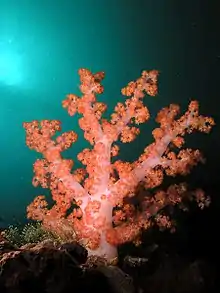 Pink soft coral
Pink soft coral
 Christmas tree worms (Spirobranchus giganteus)
Christmas tree worms (Spirobranchus giganteus)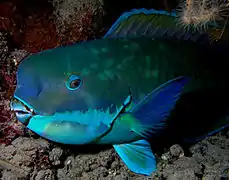
.jpg.webp)
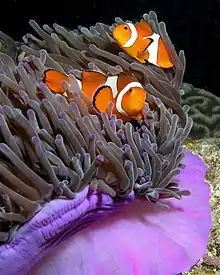 Anemonefish (Amphiprion ocellaris)
Anemonefish (Amphiprion ocellaris) White-eyed moray eel (Gymnothorax thyrsoideus)
White-eyed moray eel (Gymnothorax thyrsoideus)
Threats
The CT sits at a crossroads of rapidly anthropogenic activities (expand in populations, economic growth and international trade)[20] and climate change.[4] Competition, predation, fishing practices, marine pollution, marine debris, dredging, sunscreen, climate change, ocean acidification (OA), disease, recreational diving, and other issues briefly described in environmental issues with coral reefs.
OA is a really vulnerable threat global threat to the coral reef ecosystem.[21] Based on the biodiversity in the CT area, the damages will come to many sectors, because the coral reef is a fundamental ecosystem in the coastal area. Started from rising levels of atmospheric CO2, the calcium carbonate decrease then enhances bioerosion and dissolution rate. The condition of CT should be in oligotrophic waters, so the light would penetrate induce photosynthesis by zooxanthellae algae. However coral reef in West Maui, Hawaii, has a sustained condition in nutrient-rich, and lower pH submarine groundwater discharging that lowers the pH on seawater. Also, the corals expose to nitrate concentrations which 50 times higher than ambient. Rates of coral calcification are substantially decreased, and rates of bioerosion are orders of magnitude higher than healthy oligotrophic waters. Measurement using heavier coral nitrogen isotope (δ15N) values shows that eutrophication of reef seawater by land‐based sources of pollution can magnify the effects of OA through nutrient-driven-bioerosion. These conditions could contribute to the collapse of coastal coral reef ecosystems sooner than current projections predict based only on OA.
The biodiversity and natural productivity of the CT are under threat from poor marine management (primarily from the coastal development, and overfishing and destructive fishing), lack of political will, poverty, high market demand, and local disregard for rare and threatened species, and climate change (warming, acidifying and rising seas). Coral reefs have experienced mass bleaching, which threaten to degrade the important ecosystems. An estimated 120 million people live within the CT, of which approximately 2.25 million are fishers who depend on healthy seas to make a living. These threats are putting at risk livelihoods, economies, and future market supplies for species such as tuna.[22] Studies have highlighted the alarming decline of coral cover in this region.[23]
Since the marine resources are a principal source of income for the population, the downstream effects of losing these critical coastal ecosystems are enormous.
Conservation
The CT is the subject of high-level conservation efforts by the region's governments, nature conservation organizations such as World Wide Fund for Nature, The Nature Conservancy and Conservation International, and donor agencies such as the Asian Development Bank, the Global Environment Facility and USAID.
Coral Triangle Initiative on Coral Reefs, Fisheries, and Food Security
On August 2007, Indonesia's President Yudhoyono proposed a multilateral partnership to "safeguard the region’s marine and coastal biological resources" with five other countries geographically located in the CT (Malaysia, Timor-Leste, Papua New Guinea, Solomon Islands, and the Philippines).[20] The multilateral partnership then named as Coral Triangle Initiative on Coral Reefs, Fisheries and Food Security (CTI-CFF).
Goals of CTI-CFF[20]
- Priority seascapes designated and effectively managed
- Ecosystem Approach to Management of Fisheries (EAFM) and other marine resources fully applied
- Marine Protected Areas (MPAs) established and effectively managed
- Climate change adaptation measures achieved
- Threatened species status improving
Meeting[20]
The solid-science resources management strength builds with the scientific support of the University and research institute. On 28 February - 1 March 2017, the 1st Meeting of the CTI-CFF University Partnership in Manado was held with aimed [24] at :
- agreeing on CTI-CFF University Partnerships conceptual framework and mechanism, and the election of CTI-University Partnership Coordinator;
- building-up tangible and collaborative programs and funding support (education, research, and outreach) among Universities and research institutes that can be developed for supporting regional capacity buildings, research needed, and outreach programs related to the CTI-CFF Regional Plan of Action (RPOA) goals as to achieved qualified CTI-CFF outcomes;
- identifying possible support and mechanism to strengthening capacity and quality of Regional Secretariat, Technical Working Groups and the National Coordination Committee to undertake their functions.
The resulted of this meeting :
- the conceptual framework and mechanism of CTI-CFF University Partnerships,
- three tangible program/actions, specifically (a). capacity building priority program which establishes international M.Sc. subject on Coral Triangle Ecosystem Governance and special assistance program for Timor-Leste in developing fisheries and marine sciences education; (b). nine research priority programs and nine identified topics; (c). outreach priority actions
- University Partnership Coordinator of CT-CFF is Prof. Dr. Grevo Gerung from Sam Ratulangi University, Indonesia for 2017-2020 and the next the 2nd Meeting of the CTI-CFF University Partnership will be held in 2018.
Delineation
The primary criteria used to delineate the CT were:
- High species biodiversity (more than 500 coral species, high biodiversity of reef fishes, foraminifera, fungi corals, and stomatopods) and habitat diversity
- On the Oceanography side, The Indonesian Throughflow region (ITF) (input = −10.7 to −18.7 Sv;output= −2.6 Sv to −9.8 Sv) gives a significant role in the CT area with its function such as regulating the global ocean circulation, the climate system, and the ecosystem sustainability, so the CT region obtain maximum marine biodiversity. Including its complex geography and circulation features, the variability transport of passages, sea surface temperature, and mesoscale variability in the CT should be defined. The seasonal and interannual variability of mixing suggests the CT area influence by ENSO and the Asian‐Australian monsoon system <ref.[25]
- Passage in the CT area such as passage can be defined in ten locations. These are (1) Makassar Strait, (2) Lifamatola Strait, (3) Lombok Strait, (4) Ombai Strait, (5) Timor Passage, (6) Luzon Strait, (7) Karimata Strait, (8) Mindoro Strait, (9) Sibutu Strait, and (10) Torres Strait. The current system on CT is influenced by North Equatorial Current (NEC); North Equatorial Countercurrent (NECC); South Equatorial Current (SEC); South Equatorial Countercurrent (SECC); Mindinao Eddy (ME); HE, Halmahera Eddy; and New Guinea Coastal Current (NGCC)<ref.[25]
There is considerable overlap between the boundaries of the CT that are based primarily on high coral biodiversity (more than 500 species), and the boundaries based on the area of greatest biodiversity for coral reef fishes.[26][27]
Media
The 2013 documentary film Journey to the South Pacific tells the story of CT conservation against the backdrop of island life.[28]
See also
- Coral Triangle Initiative on Coral Reefs, Fisheries, and Food Security
- Coral Triangle Day
- List of reefs
- Great Barrier Reef – The largest coral reef on Earth, the northern portion of which lies within the CT
References
- Weeks, Rebecca; Aliño, Porfirio M.; Atkinson, Scott; Beldia, Pacifico; Binson, Augustine; Campos, Wilfredo L.; Djohani, Rili; Green, Alison L.; Hamilton, Richard; Horigue, Vera; Jumin, Robecca; Kalim, Kay; Kasasiah, Ahsanal; Kereseka, Jimmy; Klein, Carissa; Laroya, Lynette; Magupin, Sikula; Masike, Barbara; Mohan, Candice; Da Silva Pinto, Rui Miguel; Vave-Karamui, Agnetha; Villanoy, Cesar; Welly, Marthen; White, Alan T. (4 March 2014). "Developing Marine Protected Area Networks in the Coral Triangle: Good Practices for Expanding the Coral Triangle Marine Protected Area System". Coastal Management. 42 (2): 183–205. doi:10.1080/08920753.2014.877768.
- Gray, Alex (13 September 2018). "The 'Coral Triangle' is the largest of its kind, and it's dying". Global Agenda. World Economic Forum. Retrieved 20 November 2020.
- Veron et al. Unpublished data
- Asaad, Irawan; Lundquist, Carolyn J.; Erdmann, Mark V.; Hooidonk, Ruben Van; Costello, Mark J. (5 November 2018). "Designating Spatial Priorities for Marine Biodiversity Conservation in the Coral Triangle". Front. Mar. Sci. 5: 400. doi:10.3389/fmars.2018.00400. S2CID 53294894. Retrieved 27 September 2020.
- Veron, J.E.N. 1995. Corals in space and time: biogeography and evolution of the Scleractinia. UNSW Press, Sydney, Australia: xiii + 321 pp.
- Speers, A. E., Besedin, E. Y., Palardy, J. E., & Moore, C. (2016). Impacts of climate change and ocean acidification on coral reef fisheries: an integrated ecological–economic model. Ecological economics, 128, 33-43. Retrieved 26 September 2020
- Allen, G. R. 2007 Conservation hotspots of biodiversity and endemism for Indo-Pacific coral reef fishes. Aquatic Conserv: Mar. Freshw. Ecosyst. doi:10.1002/aqc.880
- Briggs, J. C. 2005a. The marine East Indies: diversity and speciation. Journal of Biogeography 32: 1517-1522
- "ADB to help improve resources management in coral triangle". Archived from the original on 2018-03-17. Retrieved 2011-05-23.
- "Coral reef destruction spells humanitarian disaster".
- WWF Coral Triangle Program
- "Verde Island Passage".
- ""World Heritage Coral Reefs" Exhibit opens in Paris".
- Hoegh-Guldberg, O (2009). The Coral Triangle and Climate Change: Ecosystems, People, and Societies at Risk (PDF). Sydney: WWF Australia. ISBN 978-1-921031-35-9. Archived from the original (PDF) on 2017-01-17. Retrieved 2016-03-30.
- The Nature Conservancy. Coral Triangle Facts, Figures, and Calculations: Part II: Patterns of Biodiversity and Endemism, December 16, 2008
- Normile, D. (2010). Joint Expedition Discovers Deep-Sea Biodiversity, New Volcanoes.
- "Indonesia Kekurangan Ahli Taksonomi Kelautan". darilaut.id. 19 September 2020. Retrieved 29 September 2020.
- Briggs, J. C. (21 September 2009). "Diversity, endemism and evolution in the Coral Triangle". Journal of Biogeography. 36 (10): 2008–2010. doi:10.1111/j.1365-2699.2009.02146.x.
- Hernawan, Udhi Eko. "Marine biodiversity in Indonesia". Retrieved 29 September 2020.
- "CTI Regional Plan of Action | CTI-CFF". www.coraltriangleinitiative.org. Retrieved 2016-03-30.
- Prouty, N. G.; Cohen, A.; Yates, K. K.; Storlazzi, C. D.; Swarzenski, P. W.; White, D. (2017). "Vulnerability of coral reefs to bioerosion from land‐based sources of pollution". Journal of Geophysical Research: Oceans. 122 (12): 9319–9331. Bibcode:2017JGRC..122.9319P. doi:10.1002/2017JC013264.
- http://www.panda.org/what_we_do/where_we_work/coraltriangle/problems/ WWF - Problems in the Coral Triangle
- Peñaflor et al. 2009. Sea-surface temperature and thermal stress in the Coral Triangle over the past two decades. Coral Reefs 28:4. pp 841-850
- "Report of the 1st Meeting of CTI-CFF University Partnership. Manado, Indonesia, 28 February – 1 March 2017" (PDF). Coral Triangle Initiative for Coral Reefs, Fisheries, and Food. Security (CTI-CFF). Retrieved 28 September 2020.
- Castruccio, F. S.; Curchitser, E. N.; Kleypas, J. A. (19 November 2013). "A model for quantifying oceanic transport and mesoscale variability in the Coral Triangle of the Indonesian/Philippines Archipelago". Journal of Geophysical Research: Oceans. 118 (11): 6123–6144. Bibcode:2013JGRC..118.6123C. doi:10.1002/2013JC009196.
- The Nature Conservancy. 2004. Delineating the Coral Triangle, its ecoregions, and functional seascapes. Report on an expert workshop, held at the Southeast Asia Center for Marine Protected Areas, Bali, Indonesia, (April 30 - May 2, 2003), Version 1.1 (June 2004)
- Hoeksema BW. 2007.Delineation of the Indo-Malayan Centre of Maximum Marine Biodiversity: The Coral Triangle. In: W. Renema (ed.) Biogeography, Time and Place: Distributions, Barriers, and Islands, pp 117-178. Springer, Dordrecht.
- Chang, Justin (December 13, 2013). "Film Review: 'Journey to the South Pacific'". Variety. Retrieved 10 February 2014.
External links
- Coral Triangle Knowledge Network
- Coral Triangle Initiative, main site
- Coral Triangle Photo Expedition Blog
- The Nature Conservancy - Coral Triangle Center
- WWF Coral Triangle Programme - international website
- WWF Coral Triangle Programme - US website
- The biodiversity in the coral triangle of Indonesia | Why could develop so many species in Indonesia? (engl.)
